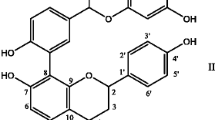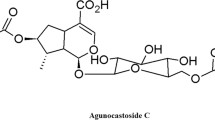Abstract
Cardiovascular diseases (CVDs) are the major health problem of advanced as well as developing countries of the world. The aim of the present study was to investigate the protective effect of the Solidago virgaurea extract on isoproterenol-induced cardiotoxicity in rats. The subcutaneous injection of isoproterenol (30 mg/kg) into rats twice at an interval of 24 h, for two consecutive days, led to a significant increase in serum lactate dehydrogenase, creatine phosphokinase, alanine transaminase, aspartate transaminase, and angiotensin-converting enzyme activities, total cholesterol, triglycerides, free serum fatty acid, cardiac tissue malondialdehyde (MDA), and nitric oxide levels and a significant decrease in levels of glutathione and superoxide dismutase in cardiac tissue as compared to the normal control group (P < 0.05). Pretreatment with S. virgaurea extract for 5 weeks at a dose of 250 mg/kg followed by isoproterenol injection significantly prevented the observed alterations. Captopril (50 mg/kg/day, given orally), an inhibitor of angiotensin-converting enzyme used as a standard cardioprotective drug, was used as a positive control in this study. The data of the present study suggest that S. virgaurea extract exerts its protective effect by decreasing MDA level and increasing the antioxidant status in isoproterenol-treated rats. The study emphasizes the beneficial action of S. virgaurea extract as a cardioprotective agent.





Similar content being viewed by others
References
Abdul Kareem M, Krushna GS, Hussain SA, Devi KL (2009) Effect of aqueous extract of nutmeg on hyperglycaemia, hyperlipidaemia and cardiac histology associated with isoproterenol-induced myocardial infarction in rats. Trop J Pharm Res 8:337–344
Achike FI, Kwan CY (2003) Nitric oxide, human diseases and the herbal products that affect the nitric oxide signaling pathway. Clin Exp Pharmacol Physiol 30:605–615
Actis-Goretta L, Ottaviani JI, Keen CL, Fraga CG (2003) Inhibition of angiotensin converting enzyme (ACE) activity by flavan-3-ols and procyanidins. FEBS Lett 555:597–600
Anandan R, Asha KK, Ammu K, Mathew S, Nair PG (2003) Effects of peroxidised PUFA on tissue defense system in experimentally induced myocardial infarction in rats. In: Surendran PK, Mathew PT, Thampuran N, Nambiar N, Joseph J, Boopendranath MR, Lakhsmanan PT, Nair PGV (eds) Seafood safety. Society of Fisheries Technologists, Cochin, pp 330–335
Arafa HM, Abd-Ellah MF, Hafez HF (2005) Abatement by naringenin of doxorubicin-induced cardiac toxicity in rats. J Egypt Natl Cancer Inst 17:291–300
Aruoma OI, Cuppett SL (1998) Antioxidant methodology in vivo and in vitro concepts. AOCS, Champaign
Asdaq SB, Sowmya SK (2010) Effect of hydroalcoholic extracts of Tylophora indica leaves in isoprenaline-induced myocardial damage in rat heart. Iran J Pharmacol Ther 9:15–20
Balasuriya BWN, Rupasinghe HPV (2011) Plant flavonoids as angiotensin converting enzyme inhibitors in regulation of hypertension. Funct Foods Health Dis 5:172–188
Behrens B, Karber G (1970) Chemotherapy of neoplastic diseases. In: Selli C, Ckhardt S, Nmeth L (eds) The publishing House of the Hungarian Academy, Budapest, pp 37
Botsoglou NA, Taitzoglou IA, Botsoglou E, Zervos I, Kokoli A, Christaki E, Nikolaidis E (2009) Effect of long term dietary administration of oregano and rosemary on the antioxidant status of rat serum, liver, kidney and heart after carbon tetrachloride induced oxidative stress. J Sci Food Agric 89:1397–1406
Brouria F, Findjia L, Mediania O, Mougenota N, Hanounb N, Naourc GL (2002) Toxic cardiac effects of catecholamines: role of β-adrenoceptor down regulation. Eur J Pharmacol 456:69–75
Chagoya DSV, Hernandez-Munoz R, Lopez-Barrera F, Yanez L, Vidrio S, Suarez J (1997) Sequential changes of energy metabolism and mitochondrial function in myocardial infarction induced by isoproterenol in rats: a long-term and integrative study. Can J Physiol Pharmacol 75:1300–1311
Das DK, Maulik N (1995) Protection against free radical injury in the heart and cardiac performance. In: Sen CK, Packer L, Hanninen O (eds) Exercise and oxygen toxicity. Elsevier, Amsterdam, pp 133–140
Das NP, Ratty AK (1986) Effect of flavonoids on induced non-enzymatic lipid peroxidation. In: Cody V, Middleton E, Harborne J (eds) Plant flavonoids in biology and medicine: biochemical, pharmacological and structure-activity relationships. Liss, New York, pp 243–247
Demir H, Açýk L, Bali EB, Koç LY, Kaynak G (2009) Antioxidant and antimicrobial activities of Solidago virgaurea extracts. Afr J Biotechnol 8:274–279
Dhalla KS, Rupp H, Beamish RE, Dhalla NS (1996) Mechanisms of alterations in cardiac membrane Ca2+ transport due to excess catecholamines. Cardiovasc Drugs Ther 1:231–238
Ebenezar KK, Sathish V, Devaki T (2003) Effect of arginine and lysine on mitochondrial function during isoproterenol induced myocardial infarction. Nutr Res 23:1269–1277
Ellman GL (1959) Tissue sulfhydryl groups. Arch Biochem Biophys 74:214–226
Falholt K, Lund B, Falholt W (1973) An easy colorimetric micromethod for routine determination of free fatty acids in plasma. CLin Chim Acta 46:105–111
Farvin KHS, Anandan R, Kumar SH, Shiny KS, Sankar TV, Thankappan TK (2004) Effect of squalene on tissue defense system in isoprenaline-induced myocardial infarction in rats. Pharmacol Res 50:231–236
Freedman DS, Gruchow HW, Anderson AJ, Rimm AA, Barboriak JJ (1988) Relation of triglyceride levels to coronary artery disease: The Milwaukee Cardiovascular Data Registry. Am J Epidemiol 127:1118–1130
Frings CS, Fendley TW, Dunn RT, Queen CA (1972) Improved determination of total serum lipids by the sulfo-phospho-vanillin reaction. Am J Clin Pathol 18:673–674
Fugh-Berman A (2000) Herbs and dietary supplements in the prevention and treatment of cardiovascular disease. Prev Cardiol 3:24–32
Gersh BJ, Sliwa K, Mayosi BM, Yusuf S (2010) The epidemic of cardiovascular disease in the developing world: global implications. Eur Heart J 31:642–648
Hearse DJ (1991) Prospects for antioxidant therapy in cardiovascular medicine. Am J Med 91:118S–121S
Hurst PL, Lovell-Smith CJ (1981) Optimized assay for serum angiotensin-converting enzyme activity. Clin Chem 27:2048–2052
Israili ZH, Hall WD (1992) Cough and angioneurotic edema associated with angiotensin-converting enzyme inhibitor therapy. A review of the literature and pathophysiology. Ann Intern Med 117:234–242
Jagota S, Dani H (1982) A new colorimetric technique for estimation of vitamin C. Biochemistry 127:178–182
Karthikeyan K, SaralaBai BR, Devaraj N (2007) Cardioprotective effect of grape seed proanthocyanidins on isoproterenol-induced myocardial injury in rats. Int J Cardiol 115:326–333
Kothari S, Jain AK, Mehta SC, Tonpay SD (2011) Hypolipidemic effect of fresh Triticum aestivum (wheat) grass juice in hypercholesterolemic rats. Acta Pol Pharm 68:291–294
Krenek P, Kmecova J, Kucerova D, Bajuszoval Z, Musil P, Gazova A, Ochodnicky P, Klimasl J, Kyselovic J (2009) Isoproterenol-induced heart failure in the rat is associated with nitric oxide-dependent functional alterations of cardiac function. Eur J Heart Fail 11:140–146
Kwon EK, Lee DY, Lee H, Kim DO, Baek NI, Kim YE, Kim HY (2010) Flavonoids from the buds of Rosa damascena inhibit the activity of 3-hydroxy-3-methylglutaryl-coenzyme a reductase and angiotensin I-converting enzyme. J Agric Food Chem 58:882–886
Laurençon L, Sarrazin E, Chevalier M, Prêcheur I, Herbette G, Fernandez X (2013) Triterpenoid saponins from the aerial parts of Solidago virgaurea alpestris with inhibiting activity of Candida albicans yeast-hyphal conversion. Phytochemistry 86:103–111
Manjula TS, Geetha A, Devi CS (1992) Effect of aspirin on isoproterenol induced myocardial infarction—a pilot study. Indian J Biochem Biophys 29:378–379
Misra HP, Fridovich T (1972) The role of superoxide ion in the auto-oxidation of epinephrine and a simple assay for superoxide dismutase. J Biol Chem 247:3170–3175
Nivethetha M, Jayasri J, Brindha P (2009) Effects of Muntingia calabura L. on isoproterenol-induced myocardial infarction. Singap Med J 50:300–302
Ohkawa H, Ohishi N, Yagi K (1979) Assay of lipid peroxide in animal tissue by thiobarbituric acid reaction. Ann Biochem 95:351–358
Ojeda D, Jiménez-Ferrer E, Zamilpa A, Herrera-Arellano A, Tortoriello J, Alvarez L (2010) Inhibition of angiotensin converting enzyme (ACE) activity by the anthocyanins delphinidin- and cyanidin- 3-O-sambubiosides from Hibiscus sabdariffa. J Ethnopharmacol 127:7–10
Ojha S, Bhatia J, Arora S, Golechha M, Kumari S, Arya DS (2011) Cardioprotective effects of Commiphora mukul against isoprenaline-induced cardiotoxicity: a biochemical and histopathological evaluation. J Environ Biol 32:731–738
Olapade EO (1995) Foods and herbs on diabetes mellitus. NARL Specialist Clinic Publications, Ibadan, pp 1–5
Oliveira EM, Krieger JE (2005) Chronic beta-adrenoceptor stimulation and cardiac hypertrophy with no induction of circulating renin. Eur J Pharmacol 520:135–141
Paritha A, Devi CS (1997) Effect of α-tocopherol on isoproterenol-induced changes in lipid and lipoprotein profile in rats. Indian J Pharmacol 29:399–404
Pechanova O (2007) Contribution of captopril thiol group to the prevention of spontaneous hypertension. Physiol Res 56:S41–S48
Rajadurai M, Prince PSM (2005) Comparative effects of Aegle marmelos extract and alpha-tocopherol on serum lipids, lipid peroxides and cardiac enzyme levels in rats with isoproterenol-induced myocardial infarction. Singap Med J 46:78–81
Sacco G, Mario B, Lopez G, Evangelista S, Manzini S, Maggi CA (2009) ACE inhibition and protection from doxorubicin-induced cardiotoxicity in the rat. Vasc Pharmacol 50:166–170
Sevenian A, Hochstein P (1985) Mechanisms and consequences of lipid peroxidation in biological systems. Annu Rev Nutr 5:365–375
Sivakumar R, Rajesh R, Buddhan S (2007) Antilipidemic effect of chitosan against experimentally induced myocardial infarction in rats. J Cell Anim Biol 1:71–77
Stevenson DE, Hurst RD (2007) Polyphenolic phytochemicals—just antioxidants or much more? Cell Mol Life Sci 64:2900–2916
Thiem B, Wesołowska M, Skrzypczak L, Budzianowski J (2001) Phenolic compounds in two Solidago L. species from in vitro culture. Acta Pol Pharm 58:277–281
Thygesen K, Alpert JS, White HD (2007) Universal definition of myocardial infarction. Eur Heart J 28:2525–2538
Topping DL, Storer GB, Calvert GD, Illman RJ, Oakenfull DG, Weller RA (1980) Effects of dietary saponins on fecal bile acids and neutral sterols, plasma lipids and lipoprotein turnover in the pig. Am J Clin Nutr 33:783–786
Trivedi PC (2004) Herbal drugs and biotechnology. Pointer, Jaipur
Vaage J, Valen G (1993) Pathophysiology and mediators of ischemia reperfusion injury with special reference to cardiac surgery. Scand J Thorac Cardiovasc Surg 41:1–18
Vinson JA, Yong H, Xuchui S, Zubik L (1998) Phenol antioxidant quantity and quality in foods: vegetables. J Agric Food Chem 46:3630–3634
Wang W (2002) Brief introduction of the third international academic seminar on hypertension and the related diseases. Chin J hypertens 10:63–93
Wittevean SAGJ, Hemkar HC, Hollar L, Hermens W (1975) The quantification of infarct size in man by means of plasma enzyme level. Br Heart J 37:795–803
Acknowledgments
The author thanks the members of Phytochemistry Laboratory, National Organization for Drug Control & Research, Cairo, Egypt, for supplying the extract kindly.
Conflict of interest
The author declares that there is no conflict of interest.
Author information
Authors and Affiliations
Corresponding author
Rights and permissions
About this article
Cite this article
El-Tantawy, W.H. Biochemical effects of Solidago virgaurea extract on experimental cardiotoxicity. J Physiol Biochem 70, 33–42 (2014). https://doi.org/10.1007/s13105-013-0277-0
Received:
Accepted:
Published:
Issue Date:
DOI: https://doi.org/10.1007/s13105-013-0277-0




